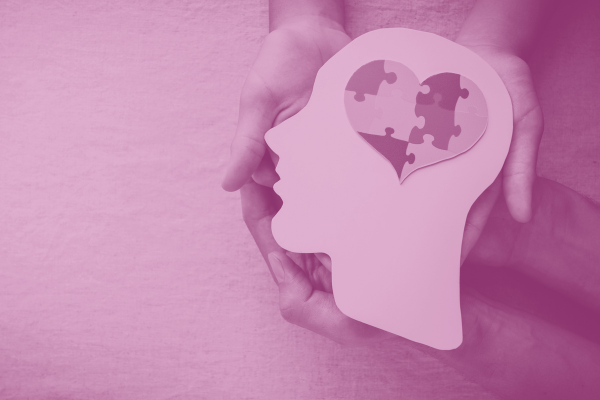May is Mental Health Awareness Month. While mental health is always a focus of our work with our clients, building a healthy, trauma-informed culture among our staff is also critical. Nonprofit staff, particularly those working with survivors of violence, often suffer from high levels of burnout and secondary trauma.
The Trauma-Informed Resilience-Oriented Learning Community (TIROC) led by Tahirih staff members began at Tahirih in 2020 with the goal of shifting the culture at Tahirih to promote psychological safety and support integration of the trauma-informed approach into our work with clients and each other.
Together, they provided the following insight on how we can build a healthy, resilient workplace culture that incorporates policies and practices to promote staff wellbeing.
Why is it important for a group like TIROC focused on well-being and staff resilience to exist at a service organization like Tahirih?
Many of our staff work directly with clients who have experienced trauma, and many of our staff are survivors themselves. To build a sustainable movement within the anti-violence, anti-oppression space, we must incorporate trauma-informed, resilience-oriented practices to support our colleagues and ourselves. By doing so, we can counter the effects of secondary trauma that come from listening to stories of violence every day. We help prevent burnout, increase job satisfaction and the meaning our work brings us, we improve our short and long-term health outcomes, and sustain our work long-term.
Define burnout and secondary trauma. What’s the difference between them?
Burnout describes the physical and emotional exhaustion that some people may feel when they experience low satisfaction and feelings of overwhelm at work. It is a chronic job stress that impacts one’s professional life and spills over to our personal lives and cannot be resolved with a temporary break from work. One may recognize burnout when a person’s behavior begins to shift, and they become increasingly isolated, begin to miss more days at work, become more sensitive to feedback than they used to be, and/or begin to experience lower productivity at work. These indicators may also be accompanied by exhaustion and other physical, mental and emotional symptoms.
By contrast, secondary trauma is the emotional response that occurs after intense or repeated exposure to the trauma of others. A person experiencing secondary trauma might exhibit increased levels of anger, irritability, resentment, or cynicism at work and in their personal lives. They may have difficulty seeing multiple perspectives or new solutions, and show increased avoidance of work, relationships and/or responsibilities. Secondary trauma can also show up as emotional detachment, inability to concentrate, difficulty sleeping, or social withdrawal. Some people experience intrusive, disturbing thoughts, dissociative moments, like daydreaming, or hypervigilance and concern about the safety of those they care about.
Secondary traumatic stress sets in rapidly and mirrors post-traumatic stress, while burnout is the slow onset of feelings of hopelessness and dissatisfaction with work, often due to an unsupportive work environment.
What are some coping skills and strategies that individuals can use to build resilience?
Individuals have lots of options for building resilience to mitigate the effects of burn out and secondary trauma. Resilience is not an innate trait that we are born with, but a skill that we can build over time. The first step is to have an awareness about shifts in our own behavior, so that we can incorporate supportive practices and can communicate our needs to others.
Building resilience is a daily practice that can include: taking regular breaks during the day, especially after hearing details of trauma or violence; eating and drinking water to support our bodies; developing good sleeping habits; seeking social and emotional connection; moving our bodies; being able to carve out and balance personal time from work time; and speaking to a professional to gain insight into how our own trauma impacts our daily lives and influences the way we engage at with those around us.
All these daily practices can support our ability to build resiliency over time, but at Tahirih, our community believes—and research shows—that organizational resilience is essential to empowering individuals to mitigate the effects of burnout and secondary trauma.
What are some policies and strategies that organizations can adopt to build a culture of resilience?
Each of us individually and all of us collectively are instrumental in building a culture of resiliency. We encourage our colleagues to speak up, ask questions, share difficult news with consent, report concerns promptly, express gratitude, seek expert support when needed, triage emergencies, and keep an eye on each other.
There are a variety of policies and practices that organizations can implement to build a culture of resilience. All of these start with empowering staff to provide feedback about what supports are needed, providing choices, and encouraging staff to participate and take advantage of benefits available.
Some policies and practices that Tahirih has implemented include:
- Offering unlimited paid time off and wellness time during workdays to help staff decompress and recover after intense client work.
- Allowing employees to balance workplace and home care responsibilities through flexible schedule options and hybrid work arrangements.
- Offering quiet, meeting-free Fridays and personal and professional sabbaticals to create uninterrupted focus time and promote creativity.
- Providing space for connection by creating caucuses and affinity spaces for staff with shared identities and more communal spaces in offices for staff to connect and support one another.
- The incorporation of trauma-informed principles into onboarding, supervision, leadership training, and meeting guidelines.
- Focusing on growth without overburdening staff by developing tools to assess proper workloads for staff that take into consideration staff experience and skills and offering mentorship and coaching to support growth.
- Prioritizing professional development allows staff to acquire new knowledge and hone skills to address the ever-complex challenges we face in the anti-violence, anti-oppression movement.
- Providing robust benefits and an employee assistance plan provide concrete resources supporting physical, mental and emotional health.
- Instituting a clear code of conduct, a grievance process, an anti-retaliation policy, and a conflict resolution policy, which are essential to promote psychological and physical safety for all.
Our TIROC team members are Feamma Reyes, Sr. Social Services Advocate; Christine Hakizimana, Director of Organizational Development; Rachel Sheridan, Sr. Litigation Counsel; Dulce Jacobo, Sr. Social Services Advocate; Adriana Lopez, Co-Director of Client Advocacy; Laura Hernandez, Sr. Social Services Advocate; and Matthew Bratek, Sr. Legal Advocate.


